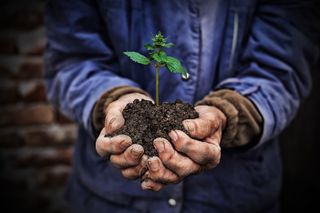Earth's Soil Is Hyperventilating Thanks To Climate Change

You know it's hot out there when even the soil is hyperventilating.
According to a new study published yesterday (Aug. 1) in the journal Nature, there's about twice as much carbon dioxide (CO2) stored in Earth's soil as there is floating around the atmosphere, and for the last few decades, that underground greenhouse gas has been leaking out at a significantly increased rate.
Based on more than 2,000 sources of climate data taken from ecosystems around the world, a team of soil scientists found that the rate of CO2 released from Earth's soil has increased globally by about 1.2 percent in just 25 years — and you can blame that on hot, hungry microbes.
"We're talking about a huge quantity of carbon," study co-author Vanessa Bailey, a soil scientist at Pacific Northwest National Laboratory in Washington state, said in a statement. "Microbes exert an outsize influence on the world that is very hard to measure on such a large scale."
The breathing Earth
Dirt doesn't actually breathe, of course, but it sort of looks that way when tiny, underground organisms help release the CO2 stored in plant roots, dead leaves and other natural detritus. Hungry microbes gorge on the tasty carbon stored in this plant matter, and then release carbon dioxide as a natural byproduct of this feeding, just as you do when you exhale after a deep breath.
This process is known as "soil respiration," and it's an important complement to photosynthesis — the process by which plants turn CO2, water and light into energy — helping to keep ecosystems around the world running smoothly.
But lately, researchers have found that as global temperatures rise, microbes in the soil have been releasing CO2 faster than plants can snatch it up again. Previous studies have indicated that tree roots and certain microbes both respire more frequently at higher temperatures (up until a certain point, when the intense heat causes the organisms to stop functioning completely). But the exact effects of that increase in respiration had never been studied on a global scale until now.
Sign up for the Live Science daily newsletter now
Get the world’s most fascinating discoveries delivered straight to your inbox.
To better understand the potential links between rising global temperatures and soil respiration, a team of researchers led by Ben Bond-Lamberty at the Joint Global Change Research Institute at the University of Maryland, College Park, examined data from two huge global nature surveys: the Global Soil Respiration Database and FLUXNET, which collectively draw soil, temperature, rainfall and other data from a network of more than 2,000 sources across several ecosystems.
The data showed that the rate of global soil respiration had increased by about 1.2 percent in the 25-year window between 1990 and 2014. Most of that growth was due to increased microbial action; the tiny creatures in Earth's soil are freeing more and more greenhouse gases from our planet's surface.
The panting Earth
While a 1.2 percent increase might not seem significant on its face, the researchers made it clear that even a modest change like this represents a "massive" ecosystem shift over a relatively short time. And while the full effects of this microbial huffing and puffing are hard to estimate, it's possible that all that extra CO2 will feed a self-intensifying loop of atmospheric warming and soil respiration over the years to come.
"Depending on how other components of the carbon cycle might respond due to climate warming, these soil changes can potentially contribute to even higher temperatures due to a feedback loop," Bond-Lamberty said in the statement. "Soils around the globe are responding to a warming climate, which in turn can convert more carbon into carbon dioxide which enters the atmosphere."
The study has several limitations, the authors noted. The data examined came mainly from studies of the Northern Hemisphere and included only spotty surveys of high Arctic latitudes and the tropics, so does not represent a complete picture of the planet's soil. It's also very hard to tease out cause and effect in any observational study like this one, the authors wrote, so further analysis of ecosystems around the world is required.
Originally published on Live Science.

Brandon is the space/physics editor at Live Science. His writing has appeared in The Washington Post, Reader's Digest, CBS.com, the Richard Dawkins Foundation website and other outlets. He holds a bachelor's degree in creative writing from the University of Arizona, with minors in journalism and media arts. He enjoys writing most about space, geoscience and the mysteries of the universe.
